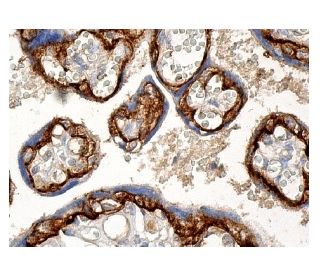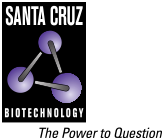
Click on image or enlarge button to enlarge
α-dystroglycan Antibody (IIH6): sc-53987
- α-dystroglycan Antibody (IIH6) is a mouse monoclonal IgM κ α-dystroglycan antibody, cited in 30 publications, provided at 200 µg/ml
- raised against purified dystrophin-glycoprotein complex of rabbit origin
- recommended for detection of α-dystroglycan of mouse, rat, human, rabbit and canine origin by WB, IP, IF and IHC(P)
- Contact our Technical Service Department (or your local Distributor) for more information on how to receive a FREE 10 µg sample of α-dystroglycan (IIH6): sc-53987.
- m-IgGκ BP-HRP is the preferred secondary detection reagent for α-dystroglycan Antibody (IIH6) for WB and IHC(P) applications. This reagent is now offered in a bundle with α-dystroglycan Antibody (IIH6) (see ordering information below). For additional m-IgGκ BP conjugates see our complete list of Mouse IgG Binding Proteins.
QUICK LINKS
α-dystroglycan Antibody (IIH6) is an IgM κ mouse monoclonal alpha-dystroglycan antibody (also designated DAG1 antibody or Alpha Dystroglycan antibody) that detects the alpha-dystroglycan protein of mouse, rat, human, rabbit and canine origin by WB, IP, IF and IHC(P). α-dystroglycan Antibody (IIH6) is available as both the non-conjugated anti-alpha-dystroglycan antibody, and multiple Alexa Fluor® conjugates. Dystroglycan (DG) is a cell surface receptor for several extracellular matrix molecules including laminins, Agrin and Perlecan. Dystroglycan function is required for the formation of basement membranes in early development and the organization of Laminin on the cell surface. α-dystroglycan is a membrane- associated, extracellular glycoprotein that is anchored to the cell-membrane by binding to the transmembrane glycoprotein α-dystroglycan to form an α/β-dystroglycan-complex. Additionally, dystroglycan is part of a multimolecular complex, where it associates with dystrophin, at the sarcolemma, to form the dystrophin-associated protein complex, or with utrophin, at the neuromuscular junction, to form the utrophin-associated protein complex. Dystroglycan is also thought to participate in the clustering of nicotinic acetylcholine receptors at the neuromuscular junction.
Alexa Fluor® is a trademark of Molecular Probes Inc., OR., USA
LI-COR® and Odyssey® are registered trademarks of LI-COR Biosciences
References:
- Chimaeric mice deficient in dystroglycans develop muscular dystrophy and have disrupted myoneural synapses. | Côtε, PD., et al. 1999. Nat Genet. 23: 338-42. PMID: 10610181
- Differential targeting of components of the dystrophin complex to the postsynaptic membrane. | Marchand, S., et al. 2001. Eur J Neurosci. 13: 221-9. PMID: 11168526
- Distinct roles for dystroglycan, beta1 integrin and perlecan in cell surface laminin organization. | Henry, MD., et al. 2001. J Cell Sci. 114: 1137-44. PMID: 11228157
- Expression of dystroglycan complex in satellite cells of dorsal root ganglia. | Masaki, T., et al. 2001. Acta Neuropathol. 101: 174-8. PMID: 11271373
- Syntheses of alpha-dystroglycan derived glycosyl amino acids carrying a novel mannosyl serine/threonine linkage. | Seifert, J., et al. 2000. Glycoconj J. 17: 407-23. PMID: 11294507
- Dystroglycan: a possible mediator for reducing congenital muscular dystrophy? | Sciandra, F., et al. 2007. Trends Biotechnol. 25: 262-8. PMID: 17416431
- Inflammation and response to steroid treatment in limb-girdle muscular dystrophy 2I. | Darin, N., et al. 2007. Eur J Paediatr Neurol. 11: 353-7. PMID: 17446099
- Expression of the murine Pomt1 gene in both the developing brain and adult muscle tissues and its relationship with clinical aspects of Walker-Warburg syndrome. | Prados, B., et al. 2007. Am J Pathol. 170: 1659-68. PMID: 17456771
- Localized treatment with a novel FDA-approved proteasome inhibitor blocks the degradation of dystrophin and dystrophin-associated proteins in mdx mice. | Bonuccelli, G., et al. 2007. Cell Cycle. 6: 1242-8. PMID: 17495527
Ordering Information
| Product Name | Catalog # | UNIT | Price | Qty | FAVORITES | |
α-dystroglycan Antibody (IIH6) | sc-53987 | 200 µg/ml | $310.00 | |||
α-dystroglycan Antibody (IIH6): m-IgGκ BP-HRP Bundle | sc-521003 | 200 µg Ab, 40 µg BP | $348.00 |
